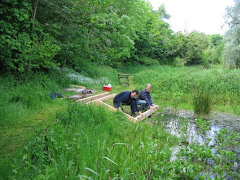We manage a long tract of land known as Boars Well. It was at this site, long ago, where the incident occurred that gave the Bradford Coat of Arm's it's tongueless Boars Head. A bounty had been put on the head of a boar that had been terrorising the peace loving folk of little Bradford village. One man who came across the boar drinking at the well on this site killed it, cut off it's tongue and set off for the town hall to claim his bounty. Another man who had been watching this, let the first man leave then cut off the boars head, put it on his cart and took it double-speed to the town hall. When he got there he couldn't explain why the head was tongueless until the real boar-killer turned up and claimed the bounty that was rightfully his!
On Friday we were eradicating different pests: Himalayan Balsam and Japanese Knotweed. Both these invasive species left unchecked would take over the entire site, crowding out our native species and leading to a decline in biodiversity along the food chain. Because they don't originate from these shores there is very little natural control because the wildlife hasn't evolved to eat them. The elephant hawk-moth has been found to eat himalayan balsam. They do their best, bless 'em but really we are the only thing between these invasive species and a blanket mono-culture of our whole island.
The knotweed grows massive blocking out all light beneath for the gentler folk of the plant world. One patch on our site was literally a forest. We cut the knotweed down in swathes and the council will spray the remaining stalks to really give us the advantage. Luckily himalayan balsam is easily plucked from the ground, roots and all but it is horrendously abundant.
Luckily we had an army of volunteers to join the fight. There were 6 new short term European volunteers, a handfull of people from the student's union, our BCEP trainee division and the usual Friday crew.
Sunday, July 15, 2007
Sunday, July 01, 2007
Urban Nature Reserve
Last Friday we cleared the already trodden paths of weeds and laid down woodchip. This was on a nature reserve that we manage, tucked away at the back of the Laisteridge Lane University of Bradford Campus.
The most exciting thing for me was when I hit stone under the soil with my fork along a few metres of the path. It was buried under a thick mulch of woodland matter but I scraped it back and voila!: there was one ready made section paved with stone! I have yet to find the extent of it but it seems quite wide. It could even turn out to be a sort of patio rather than just a narrow path. More digging next time!
The site has been through different uses. Long ago it was farmed and before we started managing it as a nature reserve it had been run as a garden. This has sparked my interest in it's history and I will try and find out more.
The Robins on the site are always completely unflustered by our presence. One landed at my feet as I was talking. It paused a while and then hopped into the undergrowth. We also saw a red damselfly and an azure blue damselfly. We can identify these after we invited an expert down to our open day last week. Children who turned up from the local community had a great time. One family was literally the nearest flat which was part of the university halls of residence. They particularly seemed to enjoy the pond dipping and they also made bird feeders and lacewing hotels. They didn't want to touch the huge and rather alien looking dragonfly nymphs though!
The most exciting thing for me was when I hit stone under the soil with my fork along a few metres of the path. It was buried under a thick mulch of woodland matter but I scraped it back and voila!: there was one ready made section paved with stone! I have yet to find the extent of it but it seems quite wide. It could even turn out to be a sort of patio rather than just a narrow path. More digging next time!
The site has been through different uses. Long ago it was farmed and before we started managing it as a nature reserve it had been run as a garden. This has sparked my interest in it's history and I will try and find out more.
The Robins on the site are always completely unflustered by our presence. One landed at my feet as I was talking. It paused a while and then hopped into the undergrowth. We also saw a red damselfly and an azure blue damselfly. We can identify these after we invited an expert down to our open day last week. Children who turned up from the local community had a great time. One family was literally the nearest flat which was part of the university halls of residence. They particularly seemed to enjoy the pond dipping and they also made bird feeders and lacewing hotels. They didn't want to touch the huge and rather alien looking dragonfly nymphs though!
Subscribe to:
Posts (Atom)
